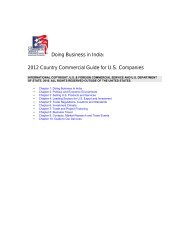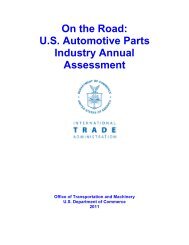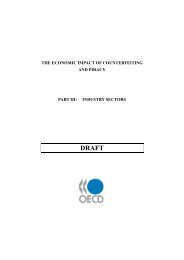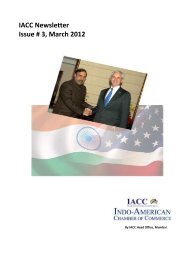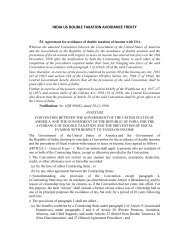Importing into the United States - Indo-American Chamber Of ...
Importing into the United States - Indo-American Chamber Of ...
Importing into the United States - Indo-American Chamber Of ...
You also want an ePaper? Increase the reach of your titles
YUMPU automatically turns print PDFs into web optimized ePapers that Google loves.
CLASSIFICATION AND VALUE<br />
27. CLASSIFICATION—LIQUIDATION<br />
CLASSIFICATION<br />
Classification, and, when ad valorem rates<br />
of duty are applicable, appraisement, are <strong>the</strong><br />
two most important factors affecting dutiable<br />
status. Classification and valuation, whe<strong>the</strong>r or<br />
not <strong>the</strong>y are pertinent because an ad valorem<br />
rate of duty applies, must be provided by commercial<br />
importers when an entry is filed. In<br />
addition, classifications under <strong>the</strong> statistical<br />
suffixes of <strong>the</strong> tariff schedules must also be furnished<br />
even though this information is not pertinent<br />
to dutiable status. Accordingly, classification<br />
is initially <strong>the</strong> responsibility of an importer,<br />
customs broker or o<strong>the</strong>r person preparing <strong>the</strong><br />
entry papers. Section 637 of <strong>the</strong> Customs Modernization<br />
Act imposes <strong>the</strong> requirement that<br />
importers exercise reasonable care when classifying<br />
and appraising merchandise.<br />
Familiarity with <strong>the</strong> organization of <strong>the</strong><br />
Harmonized Tariff Schedule of <strong>the</strong> <strong>United</strong><br />
<strong>States</strong> facilitates <strong>the</strong> classification process. (See<br />
Chapter 13 of this booklet relating to dutiable<br />
status.) The tariff schedule is divided <strong>into</strong> various<br />
sections and chapters dealing separately<br />
with merchandise in broad product categories.<br />
These categories cover animal products, vegetable<br />
products, products of various basic<br />
materials such as wood, textiles, plastics,<br />
rubber, and steel and o<strong>the</strong>r metal products in<br />
various stages of manufacture, for example.<br />
O<strong>the</strong>r sections encompass chemicals,<br />
machinery and electrical equipment, and o<strong>the</strong>r<br />
specified or non-enumerated products. The last<br />
section, Section XXII, covers certain exceptions<br />
from duty and special statutory provisions.<br />
In Sections I through XXI, products are<br />
classifiable (1) under items or descriptions<br />
which name <strong>the</strong>m, known as an eo nomine provision;<br />
(2) under provisions of general description;<br />
(3) under provisions which identify <strong>the</strong>m<br />
by component material; or (4) under provisions<br />
which encompass merchandise in accordance<br />
with its actual or principal use. When two or<br />
more provisions seem to cover <strong>the</strong> same merchandise,<br />
<strong>the</strong> prevailing provision is determined<br />
in accordance with <strong>the</strong> legal notes and<br />
<strong>the</strong> General Rules of Interpretation for <strong>the</strong> tariff<br />
schedule. Also applicable are tariff classification<br />
principles contained in administrative<br />
precedents or in <strong>the</strong> case law of <strong>the</strong> U.S. Court<br />
of International Trade (formerly <strong>the</strong> U.S. Customs<br />
Court) or <strong>the</strong> U.S. Court of Appeals for<br />
<strong>the</strong> Federal Circuit (formerly <strong>the</strong> U.S. Court of<br />
Customs and Patent Appeals).<br />
LIQUIDATION<br />
Customs officers at <strong>the</strong> port of entry or<br />
o<strong>the</strong>r officials acting on behalf of <strong>the</strong> port<br />
director review selected classifications and valuations,<br />
as well as o<strong>the</strong>r required import information,<br />
for correctness or as a proper basis for<br />
appraisement, as well as for agreement of <strong>the</strong><br />
submitted data with <strong>the</strong> merchandise actually<br />
imported. The entry summary and documentation<br />
may be accepted as submitted without any<br />
changes. In this situation, <strong>the</strong> entry is liquidated<br />
as entered. Liquidation is <strong>the</strong> point at<br />
which <strong>the</strong> Customs Service’s ascertainment of<br />
<strong>the</strong> rate and amount of duty becomes final for<br />
most purposes. Liquidation is accomplished by<br />
posting a notice on a public bulletin board at<br />
<strong>the</strong> customhouse. However, an importer may<br />
receive an advance notice on Customs Form<br />
4333A “Courtesy Notice” stating when and in<br />
what amount duty will be liquidated. This<br />
form is not <strong>the</strong> liquidation, and protest rights<br />
do not accrue until <strong>the</strong> notice is posted. Time<br />
limits for protesting do not start until <strong>the</strong> date<br />
of posting, and a protest cannot be filed before<br />
liquidation is posted.<br />
The Customs Service may determine that<br />
an entry cannot be liquidated as entered for<br />
one reason or ano<strong>the</strong>r. For example, <strong>the</strong> tariff<br />
classification may not be correct or may not be<br />
acceptable because it is not consistent with<br />
established and uniform classification practice.<br />
54 U.S. CUSTOMS SERVICE











